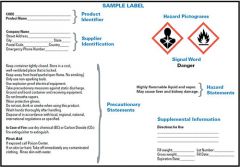The Occupational Health and Safety Administration’s (OSHA) Hazard Communication Standard (HCS) aligns with the United Nations’ Globally Harmonized System of Classification and Labeling of Chemicals (GHS). The standard requires training of employees as well as requirements for manufacturers to utilize standardized formats for container labeling and for Safety Data Sheets (SDSs), formerly known as, Material Safety Data Sheets (MSDSs).
WCM Programs
In order to comply with the OSHA Hazard Communication Standard, WCM has posted the ![]() Chemical Hazard Communication Plan for Non-Laboratories as well as the
Chemical Hazard Communication Plan for Non-Laboratories as well as the ![]() Laboratory Chemical Hygiene Plan. Information on chemical safety is also provided in EHS core safety training programs. An
Laboratory Chemical Hygiene Plan. Information on chemical safety is also provided in EHS core safety training programs. An ![]() informational sheet is available to provide an overview of the GHS program.
informational sheet is available to provide an overview of the GHS program.

Labeling Requirements (How Hazards are Communicated)
Labels can be used to quickly learn how to work with chemicals safely and how they may impact your health. All GHS compliant labels feature the following elements:
- Chemicals are classified into 16 physical, 10 health and three environmental Hazard Classes.
- Pictograms (right) are used to quickly convey these hazard classes.
- Signal Words appear on the label and include “Danger” for high hazards and “Warning” for moderate hazards.

- Precautionary Statements describe how to protect yourself (ex. Use only in well-ventilated area).
- Hazard Statement(s) describe the nature of the hazard (e.g. causes damage to kidneys through prolonged or repeated exposure when absorbed through the skin)
- Labels must also include the name, address, and phone number of the responsible party as well as the product identifier (product or chemical name).
Safety Data Sheets
The law requires that a chemical manufacturer, distributor, or importer provides Safety Data Sheets (SDSs) (formerly MSDSs or Material Safety Data Sheets) for each hazardous chemical, to communicate information to users about these hazards, in addition to what is on the label. The information contained in the SDS is required to be presented in a consistent, user-friendly, 16-section format. These sections include:
- Identification of the Substance and Supplier
- Hazard Identification
- Ingredient Composition/Information
- First Aid Measures
- Firefighting Measures
- Accidental Release Measures
- Handling and Storage
- Exposure Controls/Personal Protection
- Physical and Chemical Properties
- Stability and Reactivity Information
- Toxicological Information
- Ecological Information
- Disposal Considerations
- Transport Information
- Regulatory Information
- Other Information
Information on a chemical label is related to what can be found in the SDS. For example, the precautionary and hazard statements on the label will appear in section two of the SDS. Section eight of the SDS will always contain important protective information for a chemical user, such as engineering controls and personal protective equipment that should be used.

